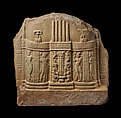Returned to lender The Met accepts temporary loans of art both for short-term exhibitions and for long-term display in its galleries.
Stupa drum slab honoring the Buddha as a flaming pillar
India, Amaravati Great Stupa, Guntur district, Andhra Pradesh
Not on view
The flaming pillar rising from an empty throne to denote the presence of the Buddha is a unique contribution of early southern Buddhism. It is probable that the motif conflates Buddhist imagery (the empty throne) with pre-Buddhist sacrificial posts (yupas) and Vedic fire (agnipuja) worship. While no known texts directly explain this imagery in a Buddhist setting, the concept combines two metaphors of divinity: the sacrificial post that the Buddha caused to appear, adorned with jewels and made entirely of gold, and its flame-emitting quality that, like the Buddha’s body, radiates brilliance. The sutras tell us that the Buddha was “upright like a golden sacrificial post; he radiated splendor.”
This image cannot be enlarged, viewed at full screen, or downloaded.
This artwork is meant to be viewed from right to left. Scroll left to view more.










